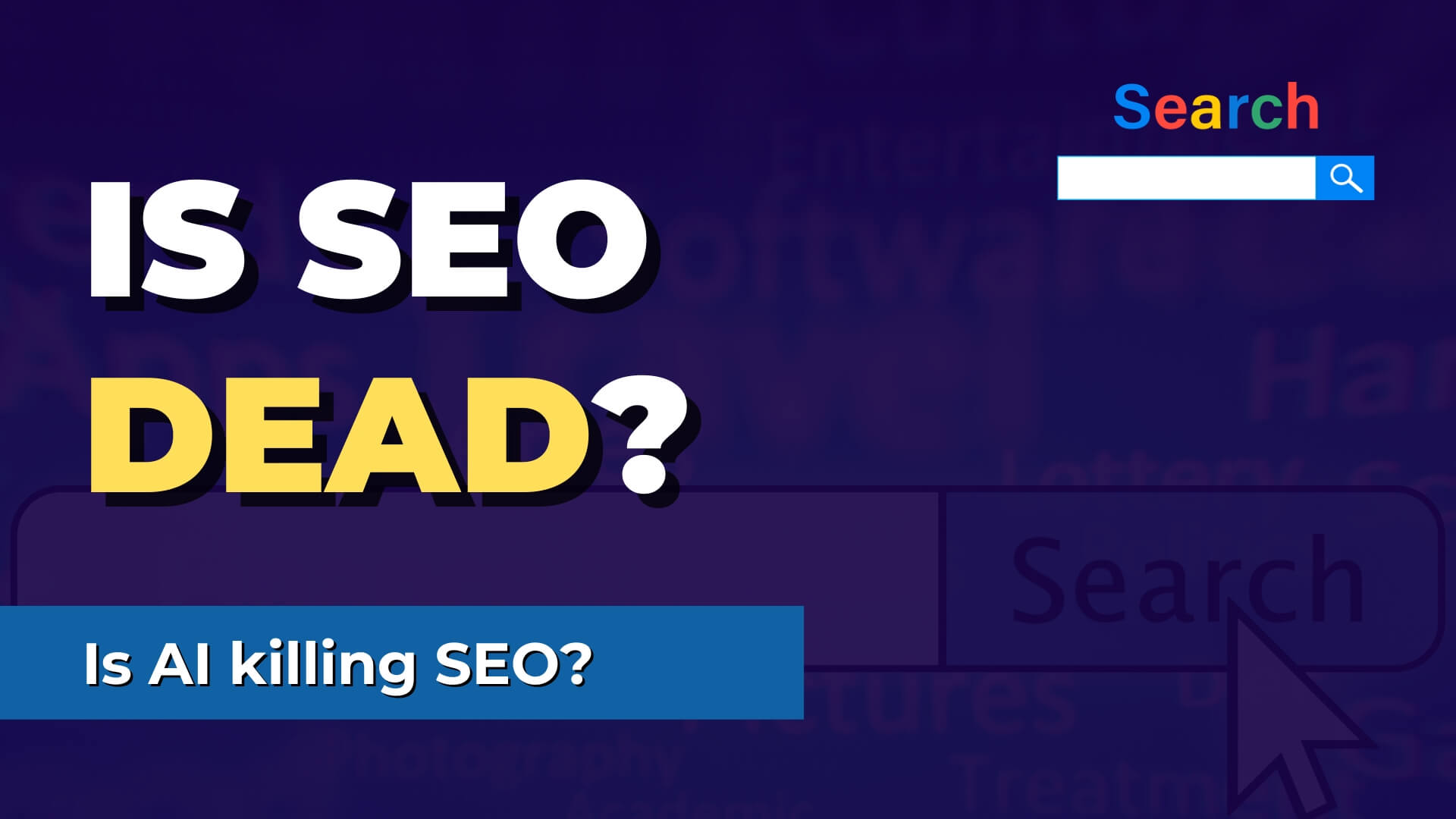Is SEO Dead?
It started with a question I was asked: What’s a reasonable monthly SEO investment?
My initial thought was the classic “how much you got?”
Then I decided to tap into my vast experience in this space and SCREECH.
Whoops, I didn’t have vast experience in SEO, or any really.
A few weeks of research, learning, and deep diving into the current state of SEO ensued and I’m going to share the highlights with you.
TL;DR: I’m going to be focusing a lot more on SEO in my business
First, let’s do some myth busting.
Most solopreneurs and creators believe that SEO means finding a few magic keywords, sprinkling them like pixie dust on your content, then watch as Google send you massive amounts of traffic and leads…
Well, the year 2005 just called and wants it’s SEO strategy back…
Back then, just having the right keywords and any backlinks would be enough to have your content rank high in search.
All you can EEAT
Today there is much more involved. Google is looking for EEAT.
- Experience
- Expertise
- Authoritativeness
- Trustworthiness
Those elements (and many more) come from Google’s Search Quality Rater Guidelines, a ~200 page PDF Google uses to train their human quality raters which direct their algorithm design.
The biggest difference in SEO today vs. years past is that no single article moves the needle on those dimensions.
It is the totality of all the content on your website and even beyond to your entire online presence, that determines your EEAT in Google’s mind.
To have a chance to rank, you need to demonstrate EEAT.
Then inside each content piece, it’s needs to be truly useful and helpful.
Case in point, Google just made a big algorithm update called the “helpful content” update that DE-RANKS content and sites that are not helpful, that are just regurgitating the same information as everyone else.
So what does work in SEO then?
The two models I found that seem to work in 2023 are:
- Really high end content and a ton of outreach and effort to get links and visibility to it.
- Publishing at high-volume, AI assisted, and covering your niche in extreme depth. Hundreds or thousands of articles.
High End Content and Outreach
#1 is what most of us are tempted into but where we don’t understand the effort and cost involved.
It’s easy to think “I’ll just dedicate a Saturday and bang out a 4,000 word definitive guide”.
You may be able to create that great content but you may not know that you are competing with folks that are running outreach campaigns to thousands of sites and blogger to get backlinks.
You would also be targeting keywords that you have zero chance of ranking for because your don’t have EEAT yet.
High Volume Content and Topical Authority
#2 is the new model that AI opens the door to. If you don’t have a a LOT of backlinks and authority, the only other way to rank is by establishing “topical authority”
What that means is covering a topic in such breadth and depth that Google will rank you because you become a primary or authoritative source.
Why would they do that? Because after advertising, Google’s second goal is to actually help people find stuff. So if many people’s search “ends” at your site because it is incredibly comprehensive, Google will rank it even if you don’t have backlinks.
Where AI comes in is making the cost more reasonable to create a high volume of content.
To establish topical authority, hundreds or thousands of posts need to be created. Paying humans to do that is a non-starter as a solopreneur or small creator.
But with AI, we can amplify our efforts.
Ok, but what’s the deal with keywords
In my research I found the answer to why I could never rank for anything despite having better content (in my clearly not humble opinion)
The reason is that Google puts all of our websites into tiers of trust (EEAT again) based on our traffic. If our site gets low traffic, we are put in a low tier. We only have a chance of ranking for keywords with low volume.
I would LOVE to rank for the keyword “content marketing”. High volume, directly related to my business, etc. But my site has nowhere near that traffic and EEAT to rank for that (yet).
So what do we do? The Avalanche strategy.
The gist of it is aim for the keywords you have a chance of ranking for, even if very low volume, then start ACCUMULATING volume (like a snowball rolling downhill)
As you accumulate that volume, you can go after slightly higher volume keywords because you now have a bit more traffic from the first set and move up a tier in Google’s eyes.
It’s basically building a pyramid where at the bottom is a LOT of articles going after low volume keywords. Then once the totality of those generates traffic, you can move up to the next layer of the pyramid.
Eventually you build your way up to the top tier keywords.
Example SEO Plan
Here’s a simplified example. I want to rank for “Content Marketing” a top tier keyword. Say it has 10,000 search volume.
What’s are secondary keywords that roll up to that one? Content Repurposing, Content Strategy, Content Plan, etc. Say those each have 1,000 search volume.
What’s are tertiary keywords for each of the secondaries? Under Content Repurposing it could be Repurpose Old Content, Repurpose Video Content, etc. Each of those may only have 100 search volume or less.
Here’s what it looks like:
Content Marketing (10,000)
Content Strategy (1,000)
Content Creation (1,000)
Content Publishing (1,000)
Content Analytics (1,000)
Content Repurposing (1,000)
Repurpose old content (100)
Repurpose software (100)
Why repurpose content (100)
Content reuse strategy (100)
The place where i have a chance of ranking now, even with no backlinks, is that bottom level.
So if I write 10 articles, targeting all the tertiary keywords under Content Repurposing, I get a shot at 10 keywords x 100 search volume. I have a good chance of ranking for those tertiary keywords and raising my site’s EEAT there. That gives me a chance to start ranking for Content Repurposing.
Then I need to do the same for all the other secondary keywords under Content Marketing (the ones on the same tiers as Content Repurposing): find their tertiary low volume keywords and target those and move up.
Once I’ve got good coverage of all the secondary keywords and my sites traffic is approaching the higher tiers, only now do I have a chance of ranking for Content Marketing.
That’s the simplified example. In reality, it would take hundreds of articles covering many of the tertiary keywords, dozens for the secondaries, and a few definitive guides related to the primary.
Why does it work? Because the process of doing all of the above established EEAT for your site AND moves you higher in the traffic tiers over time. All regardless of backlinks, though backlinks will likely come naturally as your site becomes a go to resource.
Ok so what do we do as creators and solopreneurs?
Is this a lot of work? Yes. Am I going to do it? Yes.
There are people in your niched doing this right now. Especially with AI bring the costs closer to what we as solopreneurs and creators can afford.
Either way it’s usually a long game so you need to consider SEO alongside other marketing methods like Ads, Social Media, etc.
As part of a long term diversified strategy, focusing on search as one channel totally makes sense. But no effective marketing channel is easy or cheap. Search was 15 years ago but today it takes either time, money, or both.
As I get setup to do this in my business I’ll be documenting the journey at a high level here and in more depth the Build Your Expert Business Facebook group.

David Ziembicki
David Ziembicki is the founder and CEO of the Expert Business Agency, which helps coaches, course, and membership creators build their online businesses. David has been an industry-leading technology and business consultant for over 25 years having worked at Microsoft, Deloitte, SAIC, and Avanade.

